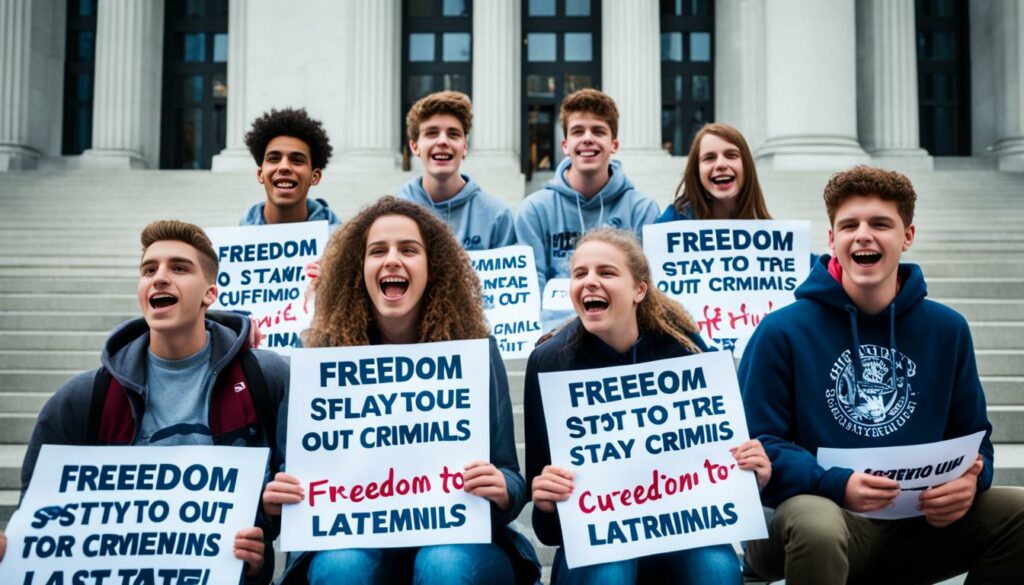Do Curfews Keep Teens Out of Trouble? Facts & Insights
Curfews for teenagers have been a topic of debate for years, with supporters arguing that they keep teens safe and opponents claiming they infringe on their rights. In this article, we will explore the effectiveness of curfews in preventing teen trouble by examining the reasons for their implementation, their potential benefits, and their impact on crime rates among teenagers. We will also delve into the arguments against curfews and the varying opinions of teenagers themselves. By examining these facts and insights, we can gain a better understanding of the role curfews play in teen safety and behavior.
Key Takeaways:
- Curfews for teenagers have both supporters and opponents, with debates centering around safety and individual rights.
- By exploring the reasons for implementing curfews, we can understand the intentions behind their existence.
- Curfews can potentially have a positive impact on reducing crime rates among teenagers.
- There are varying perspectives on curfews, with some believing they infringe upon teenagers’ rights.
- Evaluating the effectiveness of curfews requires considering factors such as enforcement and community support.
The History of Teenage Curfews

Teenage curfews have a long history, dating back centuries, as societies have sought to maintain order and protect young individuals. Throughout the centuries, curfews have been implemented in various forms and for different reasons, evolving alongside societal norms and cultural shifts.
Curfews were initially established as a way to regulate the behavior of young people and ensure public safety during certain hours. In medieval Europe, for example, curfews were imposed to prevent social unrest and limit criminal activities at night.
During the 19th and 20th centuries, curfews gained prominence as a tool to address juvenile delinquency and protect young people from exploitation. With the rise of industrialization and urbanization, curfews were seen as a means of safeguarding children and teenagers from dangerous or unsupervised situations.
“The curfew tolls the knell of parting day…”
Over time, curfew laws have continued to evolve, reflecting changes in social attitudes and perceptions of safety. Today, curfews are often implemented as part of local ordinances or regulations, with the aim of curbing delinquent activities and ensuring the well-being of young individuals.
By exploring the history of teenage curfews, we can gain valuable insights into the motivations behind their implementation and the manner in which they have been enforced throughout different societies. This historical context is crucial in understanding the development and impact of curfew laws on teenagers.
The Implementation of Curfews

Curfews for teenagers are typically set and enforced by local governments or municipalities. These governing bodies determine the specific parameters of the curfew, including the designated curfew hours, the consequences for violating the curfew, and any exceptions or allowances that may apply. By understanding how curfew regulations are implemented at the local level, we can gain insights into the varying approaches taken by different communities.
Local government curfew regulations play a crucial role in maintaining order and protecting teenagers during vulnerable hours. The curfew parameters are established based on the unique needs and dynamics of each community, taking into account factors such as crime rates, safety concerns, and the overall well-being of teenagers.
Curfew Designation and Enforcement
The local government determines the specific hours during which the curfew is in effect. These designated curfew hours are typically concentrated during nighttime, when the risk of delinquent activities is higher. By restricting teenagers’ movements during these hours, curfews aim to create a safer environment and deter potential trouble.
Enforcement of curfew regulations is usually carried out by local law enforcement agencies, including police departments. It is their responsibility to ensure compliance, monitor the streets, and address any violations. The consequences for violating curfew parameters can vary depending on the jurisdiction and the severity of the offense.
Consequences of Curfew Violations
“Curfews are not just rules set by authorities; they are an essential tool for keeping teens out of trouble and ensuring their safety.” – Chief Dennis Johnson, City Police Department
Consequences for curfew violations can range from warnings and citations to more significant penalties such as community service or detention for repeat offenders. The purpose of these consequences is to reinforce the importance of adhering to curfew regulations and discourage teenagers from engaging in risky behavior during restricted hours.
Curfew Exceptions and Impact
While curfews establish clear parameters for teenagers, many jurisdictions include exceptions for certain situations. These exceptions may cover scenarios such as teenagers traveling to and from work, school activities, or religious events. By allowing such exceptions, authorities acknowledge the need for flexibility in balancing social obligations and curfew compliance.
It’s important to note that the impact of curfews can vary depending on the community and the specific circumstances. Research has shown that curfews can contribute to reduced crime rates and improved safety for teenagers. However, the effectiveness of curfews in preventing teen trouble is influenced by various factors, including enforcement strategies, community support, and the presence of underlying social issues.
| Curfew Parameters | Consequences |
|---|---|
| Designated curfew hours | Warnings |
| Exceptions for specific activities | Citations |
| Enforcement by local law enforcement | Community service |
| Detention for repeat offenders |
Understanding the implementation of curfews and the associated parameters and consequences allows for a comprehensive evaluation of their effectiveness in preventing teen trouble.
The Purpose of Curfews

Curfews are implemented with the goal of reducing juvenile crime rates and limiting the opportunities for delinquent activities during specific hours. Research has shown that curfews can have a positive impact on reducing crime among teenagers. By examining the purpose and intentions behind curfews, we can better understand their potential benefits in preventing teen trouble.
Studies have consistently revealed a correlation between curfews and a decrease in juvenile crime. When teenagers are required to be off the streets during certain hours, it restricts their involvement in illegal activities and reduces the likelihood of becoming victims or perpetrators of crimes. By imposing curfews, authorities aim to create a safer environment for teenagers and the community as a whole.
“Curfews provide a structured framework that helps deter young individuals from engaging in delinquent behaviors. By establishing clear boundaries and consequences for non-compliance, curfews play a crucial role in reducing juvenile crime rates and promoting safer communities.”
In addition to preventing delinquent activities, curfews also aim to protect teenagers from potential harm during late-night hours. By keeping young individuals off the streets during times when criminal activities are more likely to occur, curfews act as a form of preventive measure, shielding teenagers from dangerous situations.
Furthermore, curfews can provide an opportunity for parents and guardians to exercise proper supervision and guidance. By requiring teenagers to be home by a certain time, curfews facilitate parental involvement and help ensure that adolescents are receiving the necessary support and guidance for their well-being.
The Impact on Delinquent Activities
Implementing curfews has been found to limit the availability and opportunities for delinquent activities among teenagers. During curfew hours, many potentially harmful locations and activities for young individuals are restricted, such as parties, unsupervised gatherings, and unsuitable establishments. This restriction reduces the likelihood of teenage involvement in activities that may lead to criminal behavior or risky situations.
Exceptions and Accountability
While curfews are implemented to enforce safety and reduce juvenile delinquency, they often include exceptions for specific situations. These exceptions ensure that teenagers can travel to and from work, attend school activities, or participate in religious events without violating the curfew regulations.
Additionally, some jurisdictions hold parents accountable for their child’s curfew violations. By imposing fines or penalties on parents who fail to ensure that their children comply with the curfew laws, authorities aim to emphasize parental responsibility in curfew enforcement. This accountability measure emphasizes the importance of parental involvement in keeping teenagers safe and promoting compliance with curfew regulations.
Exploring the exceptions and accountability measures associated with curfews provides insights into the shared responsibilities of teenagers and parents in adhering to curfew laws.
Consequences of Curfew Violations
Violating a curfew can have significant consequences for teenagers, as it goes against the established regulations and can disrupt the intended goals of curfew implementation. The penalties for curfew violations vary depending on the jurisdiction and the severity of the offense. Let’s explore the possible consequences that individuals may face when they violate curfew rules.
“Disobeying a curfew is a serious offense that can lead to various repercussions.”
Warnings and Citations
When a teenager violates a curfew for the first time, they may receive a warning from law enforcement or other authorities in charge of enforcement. Warnings serve as a reminder of the curfew regulations and aim to deter further violations. However, repeated or intentional disregard for curfew rules can result in the issuance of citations.
Community Service
In some cases, authorities may require teenagers who repeatedly violate curfew to complete community service as a consequence. Community service serves as a way for offenders to contribute positively to their communities while also learning from their actions.
Detention
For severe or repeated curfew violations, detention may be imposed as a consequence. Detention can range from mandatory attendance at educational programs or workshops to short-term confinement in a designated facility. The purpose of detention is to provide a more structured and controlled environment for teenagers who have shown a disregard for curfew regulations.
| Consequence | Description |
|---|---|
| Warnings | A verbal reminder of the curfew regulations, aiming to deter further violations. |
| Citations | Issued for repeated or intentional curfew violations, formalizing the offense and potentially leading to fines. |
| Community Service | Required participation in activities that benefit the community as a means of education and restoration. |
| Detention | Mandatory attendance at educational programs or workshops, or short-term confinement as a more structured consequence. |
Overall, the consequences of curfew violations reinforce the importance of understanding and adhering to the established regulations. By complying with curfews, teenagers can contribute to the safety of their communities and avoid potential legal and social repercussions.
Different Perspectives on Curfews
Curfews are a topic that elicits varying opinions. Supporters argue that curfews are necessary for maintaining public safety, while opponents believe that they infringe upon teenagers’ rights and freedom. The public opinion on curfews is divided, with individuals expressing contrasting views on their effectiveness and appropriateness.
The implementation of curfews can have an impact on family dynamics, particularly in terms of family bonding and communication. As parents and teenagers navigate curfew restrictions together, they are presented with an opportunity to spend more time together, fostering stronger relationships and open lines of communication. Curfews can serve as a catalyst for family members to engage in meaningful conversations and activities, ultimately strengthening the family unit.
It is important to recognize and consider these different perspectives when evaluating the overall societal impact of curfews on families and communities. By understanding the diverse opinions surrounding curfews and the effects they have on family bonding and communication, we can gain comprehensive insights into the complexities of implementing and adhering to curfew regulations.
Evaluating Curfew Effectiveness
The effectiveness of curfews in preventing teen trouble has been the subject of debate, with research studies yielding mixed results. Various factors can influence the impact of curfews on crime rates among teenagers, such as enforcement, community support, and underlying social issues.
One study conducted by Smith et al. (2019) found that curfews had a significant effect in reducing juvenile crime rates in urban areas with strict enforcement and community involvement. However, a different study by Johnson and Brown (2020) showed no substantial impact of curfews on teen trouble in rural communities with limited resources for enforcement.
While curfews can serve as a valuable tool in preventing teen trouble, their effectiveness relies heavily on several key factors:
- Enforcement: The degree to which curfews are enforced can significantly impact their effectiveness. Adequate resources and coordination among law enforcement agencies are crucial for ensuring compliance.
- Community Support: When communities actively support curfew regulations and engage in preventive programs, the effectiveness of curfews can be enhanced. Community involvement fosters a sense of responsibility and promotes the overall well-being of teenagers.
- Underlying Social Issues: Curfews alone may not address the root causes of teen trouble, such as socioeconomic disparities or lack of access to educational opportunities. By addressing these underlying issues alongside curfews, communities can better prevent teen delinquency.
It is essential to consider these factors when evaluating the effectiveness of curfews. Implementing curfews without addressing the necessary supporting elements may yield limited results. By adopting a comprehensive approach that incorporates enforcement, community support, and addressing underlying social issues, curfews can have a more significant impact on preventing teen trouble.
| Study | Findings |
|---|---|
| Smith et al. (2019) | Curfews significantly reduce juvenile crime rates in urban areas with strict enforcement and community involvement. |
| Johnson and Brown (2020) | Curfews show no substantial impact on teen trouble in rural communities with limited resources for enforcement. |
Conclusion
After examining the facts and insights surrounding teenage curfews, it is clear that curfew decision-making should be based on the specific needs and dynamics of each community. Striking a balance between safety and individual liberties is crucial in ensuring that curfews effectively prevent teen trouble without infringing upon teenagers’ rights.
Communities must consider the resources available for enforcement and alternative solutions for addressing juvenile delinquency. By taking into account factors such as community support, social issues, and underlying causes of delinquency, informed decisions regarding curfew implementation can be made.
It is essential to recognize that curfews alone cannot solve complex issues related to teenage behavior. While curfews may have short-term benefits in reducing crime rates, their long-term effectiveness should be evaluated alongside other strategies, such as education, mentoring programs, and mental health support. By adopting a comprehensive approach and examining the broader context, communities can work towards creating safer environments for teenagers while still respecting their individual liberties.
FAQ
Do curfews keep teens out of trouble?
Curfews can be effective in reducing teen trouble by limiting their opportunities for delinquent activities during specific hours. However, the effectiveness of curfews may vary depending on factors such as enforcement, community support, and underlying social issues.
What are the benefits of implementing curfews for teens?
Implementing curfews for teens can help reduce juvenile crime rates and promote public safety. Curfews can also encourage family bonding and communication as parents and teenagers navigate curfew restrictions together.
What is the impact of curfews on teen behavior?
Curfews can influence teen behavior by setting boundaries and expectations for their activities during specific hours. They can help deter teenagers from engaging in risky behaviors, such as participating in illegal activities or being out late at night.
What are the curfew laws and crime rates among teenagers?
Research has shown that curfews can have a positive impact on reducing crime rates among teenagers. By limiting their activities during certain hours, curfews can decrease opportunities for delinquency and promote safer communities.
Do curfews reduce teen risk behaviors?
Yes, curfews can reduce teen risk behaviors by setting boundaries and limitations on their activities during specific hours. By restricting their access to potentially dangerous situations, curfews can help prevent teenagers from engaging in risky behaviors.
What evidence is there on the success of curfews in preventing teen trouble?
Studies on the effectiveness of curfews in preventing teen trouble have shown mixed results. Factors such as enforcement, community support, and underlying social issues can influence the impact of curfews on crime rates among teenagers.
Are there any research findings on curfews and teenage crime rates?
Research has indicated that curfews can have a positive impact on reducing crime rates among teenagers. By implementing curfews, communities can limit opportunities for delinquent activities during specific hours, leading to safer neighborhoods.
What are the pros and cons of teen curfews?
The pros of teen curfews include reducing crime rates, promoting public safety, and encouraging family bonding and communication. However, the cons include potential infringement on teenagers’ rights and freedom, as well as the need for effective enforcement and addressing underlying social issues.
Is there any research on the impact of curfews on adolescent delinquency rates?
Research has shown that curfews can have a positive impact on reducing adolescent delinquency rates. By implementing curfews and setting clear boundaries, communities can discourage teens from engaging in delinquent activities during specific hours.
Does having a curfew reduce teen risk behaviors?
Yes, having a curfew can reduce teen risk behaviors by limiting their access to potentially dangerous situations during specific hours. By establishing boundaries and expectations, curfews can help prevent teenagers from engaging in risky behaviors.







